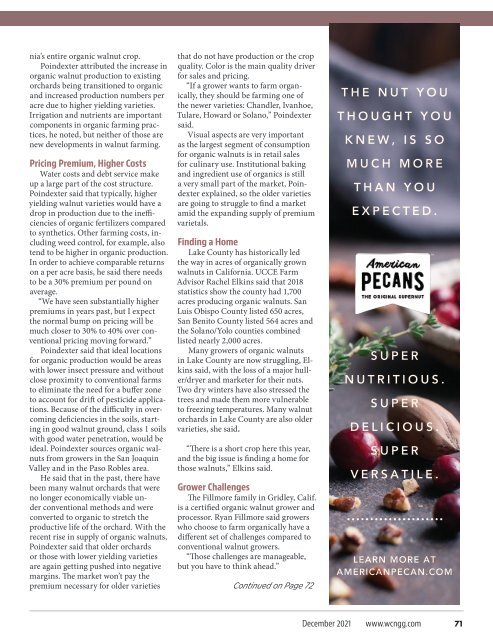WCN Dec e
Create successful ePaper yourself
Turn your PDF publications into a flip-book with our unique Google optimized e-Paper software.
nia’s entire organic walnut crop.<br />
Poindexter attributed the increase in<br />
organic walnut production to existing<br />
orchards being transitioned to organic<br />
and increased production numbers per<br />
acre due to higher yielding varieties.<br />
Irrigation and nutrients are important<br />
components in organic farming practices,<br />
he noted, but neither of those are<br />
new developments in walnut farming.<br />
Pricing Premium, Higher Costs<br />
Water costs and debt service make<br />
up a large part of the cost structure.<br />
Poindexter said that typically, higher<br />
yielding walnut varieties would have a<br />
drop in production due to the inefficiencies<br />
of organic fertilizers compared<br />
to synthetics. Other farming costs, including<br />
weed control, for example, also<br />
tend to be higher in organic production.<br />
In order to achieve comparable returns<br />
on a per acre basis, he said there needs<br />
to be a 30% premium per pound on<br />
average.<br />
“We have seen substantially higher<br />
premiums in years past, but I expect<br />
the normal bump on pricing will be<br />
much closer to 30% to 40% over conventional<br />
pricing moving forward.”<br />
Poindexter said that ideal locations<br />
for organic production would be areas<br />
with lower insect pressure and without<br />
close proximity to conventional farms<br />
to eliminate the need for a buffer zone<br />
to account for drift of pesticide applications.<br />
Because of the difficulty in overcoming<br />
deficiencies in the soils, starting<br />
in good walnut ground, class 1 soils<br />
with good water penetration, would be<br />
ideal. Poindexter sources organic walnuts<br />
from growers in the San Joaquin<br />
Valley and in the Paso Robles area.<br />
He said that in the past, there have<br />
been many walnut orchards that were<br />
no longer economically viable under<br />
conventional methods and were<br />
converted to organic to stretch the<br />
productive life of the orchard. With the<br />
recent rise in supply of organic walnuts,<br />
Poindexter said that older orchards<br />
or those with lower yielding varieties<br />
are again getting pushed into negative<br />
margins. The market won’t pay the<br />
premium necessary for older varieties<br />
that do not have production or the crop<br />
quality. Color is the main quality driver<br />
for sales and pricing.<br />
“If a grower wants to farm organically,<br />
they should be farming one of<br />
the newer varieties: Chandler, Ivanhoe,<br />
Tulare, Howard or Solano,” Poindexter<br />
said.<br />
Visual aspects are very important<br />
as the largest segment of consumption<br />
for organic walnuts is in retail sales<br />
for culinary use. Institutional baking<br />
and ingredient use of organics is still<br />
a very small part of the market, Poindexter<br />
explained, so the older varieties<br />
are going to struggle to find a market<br />
amid the expanding supply of premium<br />
varietals.<br />
Finding a Home<br />
Lake County has historically led<br />
the way in acres of organically grown<br />
walnuts in California. UCCE Farm<br />
Advisor Rachel Elkins said that 2018<br />
statistics show the county had 1,700<br />
acres producing organic walnuts. San<br />
Luis Obispo County listed 650 acres,<br />
San Benito County listed 564 acres and<br />
the Solano/Yolo counties combined<br />
listed nearly 2,000 acres.<br />
Many growers of organic walnuts<br />
in Lake County are now struggling, Elkins<br />
said, with the loss of a major huller/dryer<br />
and marketer for their nuts.<br />
Two dry winters have also stressed the<br />
trees and made them more vulnerable<br />
to freezing temperatures. Many walnut<br />
orchards in Lake County are also older<br />
varieties, she said.<br />
“There is a short crop here this year,<br />
and the big issue is finding a home for<br />
those walnuts,” Elkins said.<br />
Grower Challenges<br />
The Fillmore family in Gridley, Calif.<br />
is a certified organic walnut grower and<br />
processor. Ryan Fillmore said growers<br />
who choose to farm organically have a<br />
different set of challenges compared to<br />
conventional walnut growers.<br />
“Those challenges are manageable,<br />
but you have to think ahead.”<br />
Continued on Page 72<br />
T H E N U T Y O U<br />
T H O U G H T Y O U<br />
K N E W , I S S O<br />
M U C H M O R E<br />
T H A N Y O U<br />
E X P E C T E D .<br />
S U P E R<br />
N U T R I T I O U S .<br />
S U P E R<br />
D E L I C I O U S .<br />
S U P E R<br />
V E R S A T I L E .<br />
LEARN MORE AT<br />
AMERICANPECAN.COM<br />
<strong>Dec</strong>ember 2021 www.wcngg.com 71

















